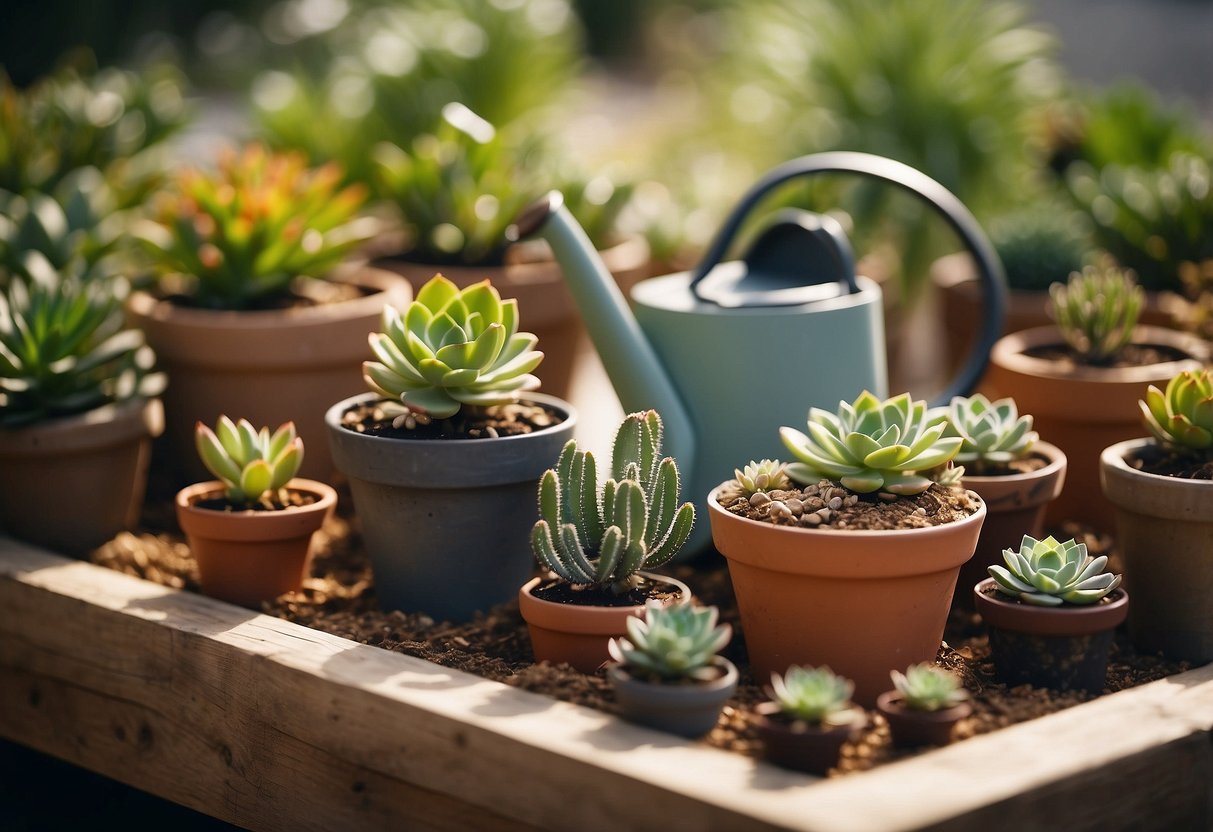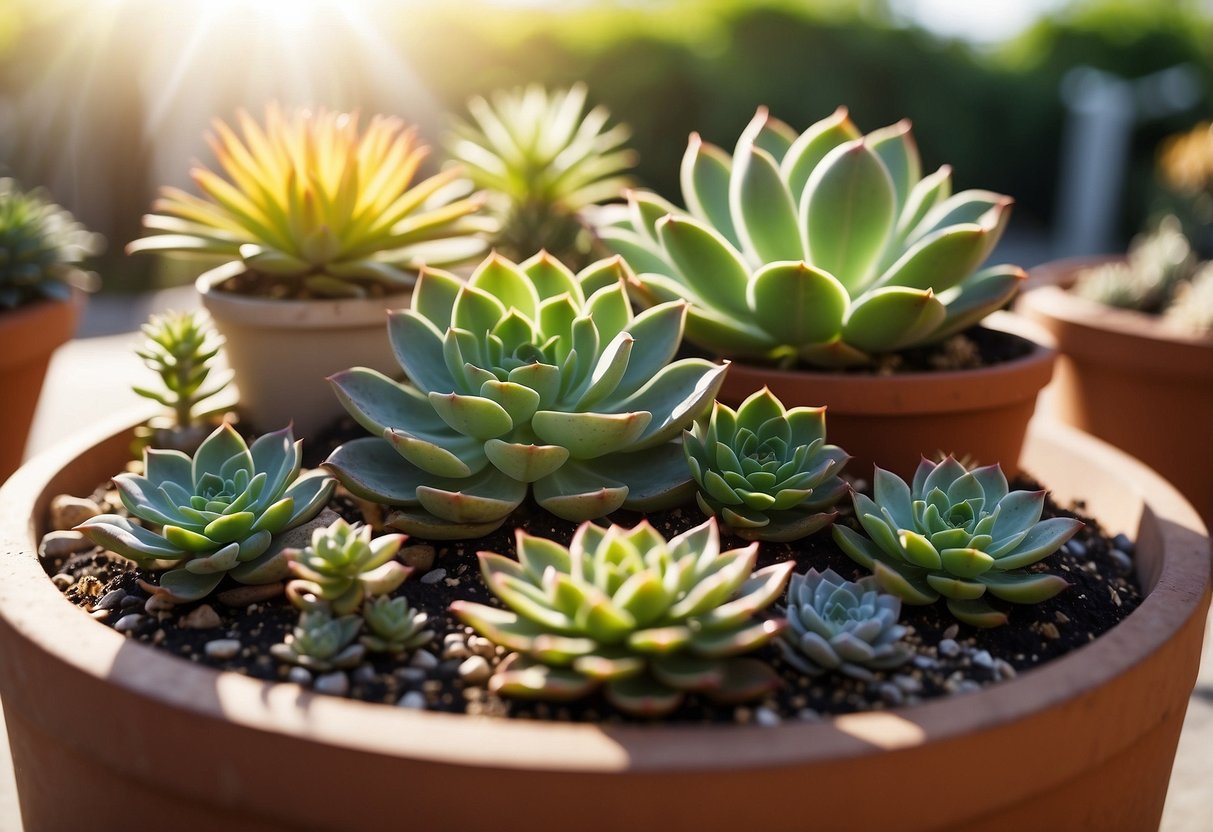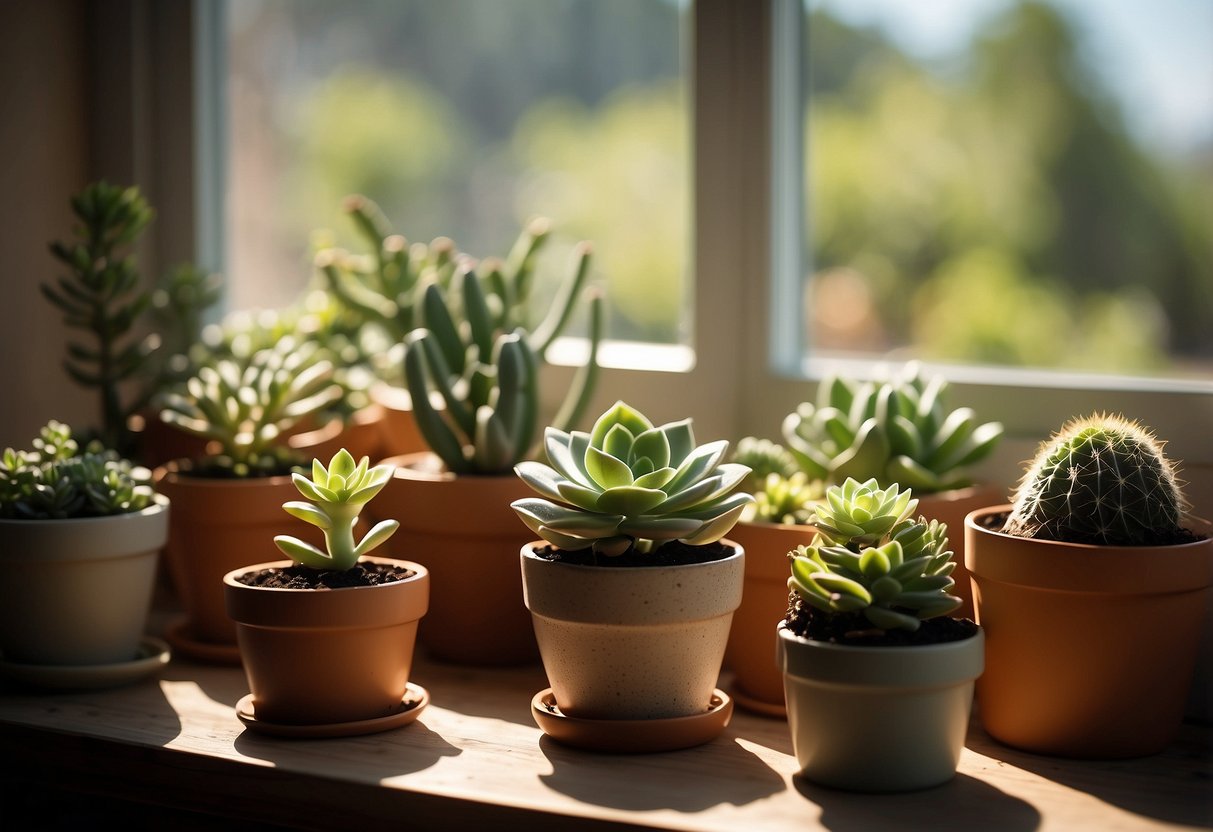Tips for Starting a Succulent Garden: Beginner’s Guide to Thriving Plants
Thinking about starting a succulent garden? You’re in for a fun and rewarding journey. Succulents are unique and hardy plants that can bring a touch of greenery and charm to any space, no matter how big or small.

Succulents are known for their low maintenance and stunning variety. Whether you’re new to gardening or have a seasoned green thumb, creating a succulent garden can be a delightful experience that suits your lifestyle and decor preferences.
1) Choose the Right Succulents

Start by selecting succulents that are easy to care for. Good options for beginners include Echeveria, Aloe Vera, and Jade Plant.
Consider the light requirements of your chosen succulents. Most thrive in full sun, but some prefer partial shade.
Think about how big the plants will grow. Make sure they fit in the space you have.
2) Plan Your Garden Layout

Think about where you want to put your succulents. Make sure it’s a spot with plenty of bright light. Indoors, a southern or eastern-facing window is perfect. If outside, choose a location with at least six hours of sunlight daily.
Next, decide on the arrangement. Group succulents with similar needs together. This makes caring for them easier. Try different heights and colors to create visual interest.
Make sure there is good drainage. Add sand or pumice to your soil to help with this. This helps prevent waterlogged roots, which can harm your plants.
3) Use Well-Draining Soil

Succulents love well-draining soil. It helps prevent their roots from getting too wet and rotting. You can find soil mixes made just for succulents, or you can mix your own.
Try adding coarse materials like perlite or pumice to regular potting soil. This makes the soil drain faster and keeps your succulents happy.
For more tips, check out this guide on creating a thriving succulent garden.
4) Provide Proper Drainage

Succulents need excellent drainage to thrive. Without good drainage, their roots can get waterlogged and rot. It’s important to use a potting mix that allows water to flow out easily.
Mix sand or pumice into your soil. This helps improve drainage and prevents the soil from staying too wet. For container plants, choose pots with drainage holes. These holes allow excess water to escape, keeping the roots healthy.
For more tips, visit Garden Design and Martha Stewart.
5) Water Sparingly

When it comes to watering succulents, less is more. These plants store water in their leaves and stems, so they don’t need frequent watering.
Wait until the soil is completely dry before giving your succulents more water. Too much water can rot their roots.
Remember, a light misting is often better than a heavy soaking.
6) Ensure Plenty of Sunlight

Succulents love the sun. They need at least six hours of direct sunlight each day to thrive.
Put your succulent garden in a spot that gets lots of bright light. This helps prevent the plants from becoming stretched out and pale.
If you’re growing succulents indoors, place them near a sunny window.
7) Protect from Pests

Keep an eye out for pests like aphids and mealybugs. These tiny bugs can harm your succulents by sucking on their juices.
If you see pests, remove them by spraying your plants with a mixture of water and a few drops of dish soap. You can also use a cotton swab dipped in alcohol to remove them.
Another way to deter pests is to keep your garden area clean. Remove fallen leaves and debris regularly to reduce hiding places for insects.
8) Use the Right Containers

Choosing the right containers is essential for your succulents. Make sure the containers have drainage holes. This helps prevent waterlogged roots, which can harm your plants.
You can find containers in various materials like clay, ceramic, or plastic. Clay pots are great because they are porous and help with airflow.
Size matters too. Ensure the container is big enough for the plant to grow but not too large to avoid excess soil that retains water.
9) Fertilize Sparingly

Fertilizing succulents is important, but you should do it sparingly. Too much fertilizer can harm your plants. It’s best to feed them once a year, usually in early to mid-spring when growth picks up.
Use a balanced, water-soluble fertilizer. Avoid fertilizing during fall and winter to prevent cold damage. During these times, your succulents are dormant and don’t need extra nutrients.
For a DIY option, you can steep compost in water for 24 to 48 hours. This makes a gentle liquid fertilizer that won’t overwhelm your succulents. Just remember, a little goes a long way!
10) Rotate Your Plants

To help your succulents grow evenly, make it a habit to rotate them regularly.
Turning your plants ensures that each side gets an equal amount of sunlight.
This simple step prevents the plants from leaning or growing unevenly. Rotate your plants every few weeks for the best results.
For more details, check out how to grow beautiful succulents that enhance your garden.
Benefits Of Growing Succulents

Easy Maintenance: Succulents are low-maintenance plants. They don’t need frequent watering and can thrive with minimal attention.
Air Purification: Many succulents, like aloe vera, help purify the air by removing toxins. This makes your indoor environment healthier.
Space-Saving: Succulents come in various sizes, making them perfect for small spaces. You can line them up on a windowsill or create a mini garden on your desk.
Aesthetic Appeal: With their unique shapes and vibrant colors, succulents can add a touch of beauty and elegance to any room or garden.
Stress Relief: Gardening and caring for plants, including succulents, can be a great way to reduce stress. Spending time with your succulents can help you relax.
Cost-Effective: Succulents are generally affordable and can multiply over time through propagation. You can start with a few and grow your collection.
Variety: There are countless types of succulents to choose from. Each has different colors, shapes, and sizes, allowing you to create a diverse and interesting garden.
Improves Focus: Having plants like succulents in your workspace can improve concentration and productivity. They provide a calming presence that can help you focus better.
Educational: Growing succulents can be an educational experience. You can learn about different species, their care requirements, and even their origins.
You can find more tips on how to plant succulents from Garden Design.
Succulents are light feeders and don’t require a lot of fertilizer, according to Gardener’s Path. This makes them a great choice for beginners.
Choosing The Right Succulents

Choosing the right succulents involves understanding your climate and deciding whether they will be grown indoors or outdoors. Both factors greatly influence which types of succulents will thrive.
Climate Considerations
Your local climate plays a big role in selecting succulents. If you live in a region with mild winters and warm summers, many succulents will do well outside. On the other hand, areas with harsh winters may require you to choose cold-tolerant varieties or plan to bring your plants indoors during the colder months.
For warmer climates, consider succulents like Echeveria and Aloe Vera. These plants love the sun and can withstand high temperatures. If your area experiences frost, opt for hardy options like Sempervivum or Sedum, which can tolerate cold weather. Check the hardiness zone for your location to ensure you pick plants that will survive year-round.
Indoor Vs. Outdoor Succulents
Indoor and outdoor environments create different growing conditions for succulents. Indoor succulents need bright, indirect light. Popular indoor choices include Jade Plant and Zebra Plant. These plants thrive on windowsills where they can get plenty of sunlight without direct exposure.
Outdoor succulents can handle more direct sunlight and need well-draining soil. Some excellent choices for outdoor gardens are Agave and Graptopetalum. Make sure to provide a proper mix of sand or pumice in the soil to enhance drainage.
Whether indoors or outdoors, you should water sparingly and allow the soil to dry out between watering. Too much water is a common mistake and can lead to root rot. Adjust your watering schedule based on the light and temperature conditions to keep your succulents happy and healthy.
Preparing Your Garden Space

Succulent gardens need special soil and the right pots to thrive. You should focus on creating good drainage and ensuring the plants get enough light.
Soil Requirements
Succulents need soil that drains very well to keep their roots healthy. Most regular garden soil holds too much water, which can lead to root rot. To improve drainage, mix coarse sand or pumice into your soil.
An ideal soil mixture includes:
- 3 parts potting soil
- 2 parts coarse sand
- 1 part pumice or perlite
This mix ensures that water does not sit around the roots for too long. You can find pre-mixed succulent soil at garden centers, which can save you some effort. Remember, the better the drainage, the healthier your succulents.
Pot Selection and Placement
The right pots are crucial for a successful succulent garden. Choose pots with drainage holes to allow excess water to escape. Without these holes, the soil can become waterlogged, harming your plants.
When selecting pots, consider the material:
- Terracotta pots: They are porous, helping excess moisture evaporate.
- Plastic pots: These are lighter but hold more water, so be careful with watering.
Place your pots where they will get plenty of light, typically a spot with at least six hours of sunlight per day. If you live in a very hot climate, you might need a spot with some afternoon shade to prevent the plants from overheating.
By focusing on the soil and pots, you set up your succulent garden for success.
Water And Light Needs

Succulent care involves understanding specific water and light needs. These plants thrive with just the right amount of water and plenty of sunlight.
Watering Schedule
Succulents store water in their leaves and stems, so they don’t need frequent watering. It’s best to water them sparingly. When the soil is dry, give your succulents a good soak. Make sure the water reaches the roots.
Over-watering can lead to root rot. A good rule of thumb is to water about once every two weeks. During their dormant winter period, you should water even less.
Using pots with drainage holes can help prevent water from sitting at the bottom. Keep the soil well-aerated and use a mix designed for succulents.
Light Exposure
Succulents love sunlight. Aim for about six hours of direct sunlight each day. This helps them grow strong and maintain their vibrant colors.
Rotating your succulents ensures all parts of the plant get enough light. Without rotation, succulents may start to lean to one side. If you notice your plants are looking pale, they might need more light.
In hot climates, protect them from intense afternoon sun to avoid sunburn. If you can’t provide enough natural light, consider using grow lights for indoor succulents.







